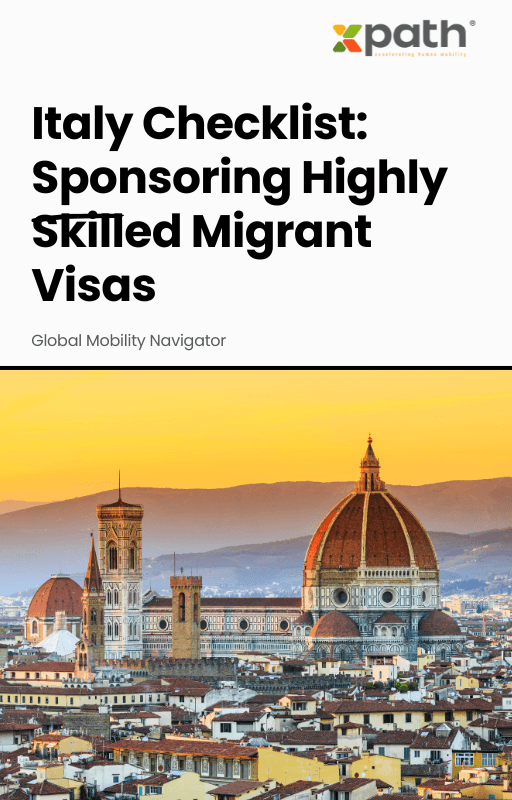Italy Checklist: Sponsoring Highly Skilled Migrant Visas
Grab a copy of a guide to international employee relocation
View E-bookIs your global mobility program still stuck in spreadsheet purgatory? If so, you’re not alone. But as talent moves faster and compliance grows more complex, the old ways just can’t keep up. This guide breaks down why making the leap to a modern mobility platform isn’t just smart—it’s essential. Let’s walk through the journey, from Excel exports to a digital-first, data-driven global mobility solution.
Spreadsheets have been the trusted sidekick of HR and mobility managers for decades. They’re convenient, flexible, and familiar. But as organizations grow and talent crosses more borders, managing assignments, tax compliance, benefits, and costs on static sheets becomes a game of whack-a-mole. According to the Gartner 2022 HR Technology Survey, companies using manual tools experience 2.5 times more errors in payroll and compliance than those using automated platforms. Throw in GDPR and ever-evolving immigration rules, and suddenly, spreadsheets start to feel as dated as dial-up internet.
Beyond error risks, spreadsheet-based mobility programs drain time and resources. The Worldwide ERC reports that global mobility program costs have risen by 15-20% annually due to increasing assignment volume and complexity. Yet, a survey by PwC found 60% of organizations still use spreadsheets and email as their primary tools—exposing them to data security breaches and inefficient processes. Assignment data in silos leads to headcount misreporting, tax exposure, duplicate payment errors, and lost productivity as teams chase updates across dozens of versions.
So, what’s the alternative? Enter modern global mobility solutions like xpath.global. These cloud-based platforms centralize every aspect—assignment tracking, tax management, relocation services, vendor coordination, compliance, and reporting—in real time. Instead of scrolling through endless columns, mobility managers see visual dashboards, automated workflows, and collaborative tools. According to Deloitte’s 2023 Global Mobility Trends Survey, 75% of organizations that migrated to automated platforms reduced assignment management time by at least 30% and improved assignee satisfaction scores by 40%.
Ready to make the switch? Here’s a practical breakdown:
Step 1: Map Your Mobility Process
Document every step—policy issuance, cost estimates, vendor interactions, payroll updates. This helps identify pain points and sets benchmarks for your new platform.
Step 2: Audit Data Quality
Clean up your existing spreadsheets. Remove outdated assignments, standardize data fields, and identify missing info. Good data in means good data out in your new system.
Step 3: Define Your Requirements
What matters most: automated compliance tracking, workflow approvals, multi-country tax integrations, user roles, reporting features? Engaging stakeholders ensures buy-in.
Step 4: Compare Mobility Platforms
Evaluate solutions—like xpath.global—for scalability, security, automation, and ease of integration. Demo features, talk to references, and review case studies.
Step 5: Plan Your Migration
Work with your platform partner to map data fields, schedule data imports, and set user permissions. Build in time for testing and feedback.
Step 6: Train and Roll Out
Run training sessions for mobility and HR teams. Provide playbooks and quick-start guides to ensure everyone’s up to speed.
Step 7: Monitor and Optimize
Use performance analytics and feedback forms to track the transition. Address bottlenecks and continually refine your program as business needs evolve.
Take the example of a multinational software company that handled over 500 annual workforce moves via Excel. With new GDPR regulations and remote work policies, their spreadsheets became a compliance nightmare. By partnering with xpath.global, they automated immigration status tracking, expense reporting, and vendor coordination. Within six months, assignment cycle times dropped by 35%, compliance breach incidents were eliminated, and mobility team satisfaction jumped to all-time highs. “Moving to a true mobility platform was like switching from a pocket calculator to a supercomputer,” their Global Mobility Lead shared.
Change is tough—no question. Data migration raises fears about lost information. Stakeholders sometimes resist automation, worrying about job relevance. Security concerns linger, especially with employee data moving to the cloud. But, choosing an established solution with experience in data migration, robust training, and proven security protocols (like xpath.global) tackles these roadblocks head-on. Most trailblazing companies even report a surge in cross-team collaboration and job satisfaction post-transition!
The world isn’t waiting, and neither should your mobility program. Transitioning from spreadsheets to a modern global mobility solution unlocks data-driven decision making, slashes operational costs, smooths compliance headaches, and boosts your team’s impact. Ready to leave the past behind and face the next era of global talent management with confidence?
How hard is it to migrate existing data from spreadsheets?
Most modern platforms, including xpath.global, offer data migration tools and hands-on support to ensure a smooth transition with minimal risk of loss or errors.
Will I lose control over my data?
Not at all! Mobility platforms centralize and secure your data but allow you to set permissions, run reports, and grant access as required—often with far more control and transparency than with spreadsheets.
How quick is the return on investment?
Organizations often see tangible efficiency gains and cost savings within 6-12 months of implementation, especially from reduced administrative work, improved compliance, and fewer errors.
What about compliance with data privacy laws?
Leading platforms like xpath.global adhere to international data security and privacy standards, including GDPR, ISO certifications, and encryption protocols.
How does employee experience improve?
Automated updates, mobile-friendly workflows, and 24/7 access to relocation resources reduce frustration for relocating staff, boosting engagement and retention.
Ready to transform your mobility program? Explore xpath.global’s solutions.

Italy Checklist: Sponsoring Highly Skilled Migrant Visas
Grab a copy of a guide to international employee relocation
View E-book